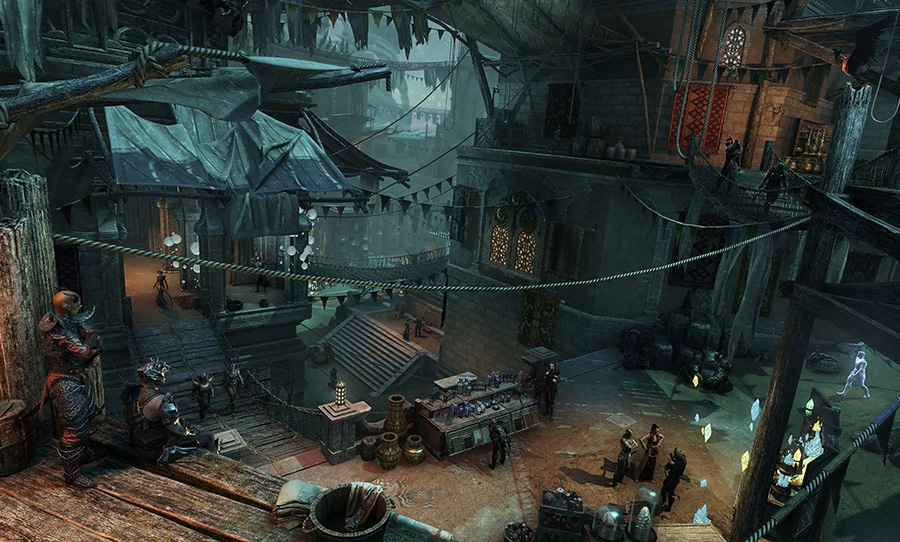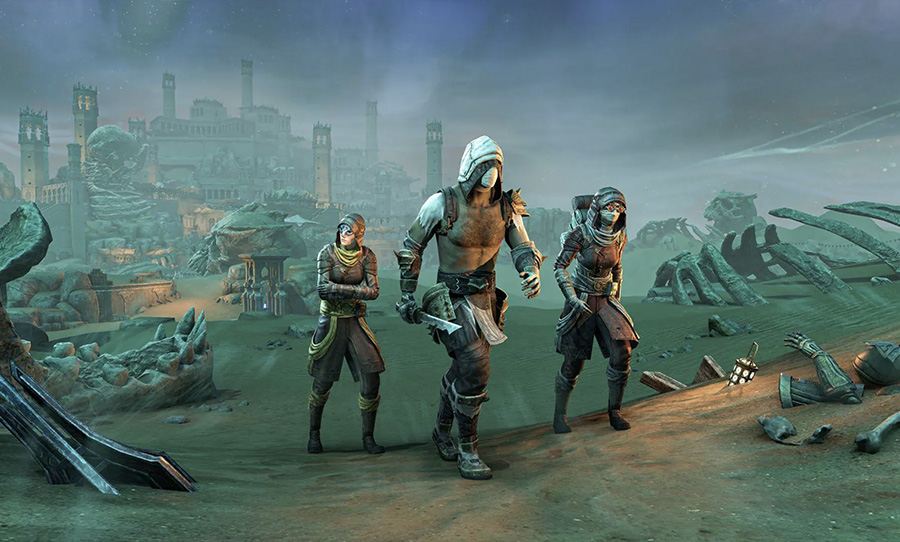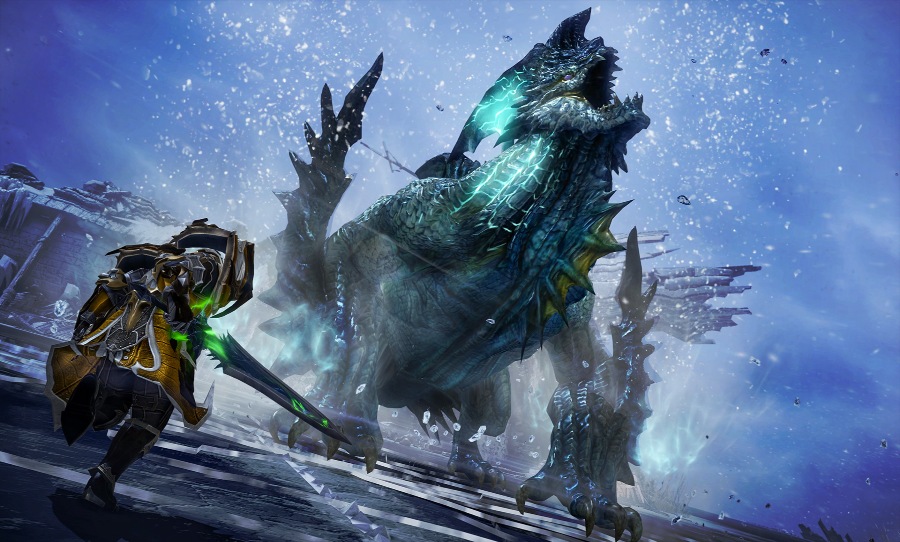With their new Deadlands DLC, The Elder Scrolls Online closes its year-long Gates of Oblivion adventure. Here’s a sneak peek of what to expect.
Recently, Clocked were made privy to a few of the new locations coming to The Elder Scrolls Online’s final 2021 DLC: Deadlands. The instalment will close the MMO’s year-long campaign focused around Daedric Prince of Destruction, Mehrunes Dagon and his personal realm of Oblivion, the Deadlands. As the DLC’s name would suggest, it’s finally time to take the battle to his home front.
Our tour guides this time around were two faces from Zenimax Online Studios; Lead Content Designer Jeremy Sera and Zone Lead Tom Murphy. Here’s what we learned.
Destination: Deadlands
Much like a swathe of other locations already added to The Elder Scrolls Online, this isn’t necessarily the first time players will have set foot in the Deadlands. ESO players will have experienced small nooks of Dagon’s domain in the recent Blackwood chapter, and even Oblivion players will have briefly visited this slice of the Daedric realms.
However, the Deadlands DLC is really the first time players will be able to explore anything akin to an open-world area of the Deadlands, or meet a meaningful amount of characters that dwell there.
In our brief time amongst the Deadlands, we visited a few chief locations; the city of Fargrave, the Wretched Spire, plus some landmarks dotting the larger zone area, including entrances to the two citadels (Ardent Hope and Destruction) which comprise Mehrunes Dagon’s seat of power.
The Deadlands at large are unfriendly, tense, and fragmented. With little resources to build from, shelters are either made from scavenged material or adapted from existing structures. Fargrave, for instance, is built under a mysterious set of gargantuan bones from a time long past, and the Wretched Spire is a community based around a sunken Dwemer spire that, as lore buffs may note, is part of Mornhold that Dagon brought back with him after attacking the city in the First Era.
A smattering of cosmic travellers, mortals and Daedra alike, are the people who inhabit this biome. They may be refugees from Dagon’s slave pits, opportunistic merchants selling rare materials, or simply folk who took a wrong turn somewhere between Nirn and Aetherius and can’t get back.
Tom described the zone as “friendly but unfriendly”, the kind of place where lightning and ash dots the sky, but you’ll always find a conversation to be had or a new lore tidbit to be discovered.

Fargrave, a city of bones
It’s hard to describe Fargrave as anything short of impressive. The city is straight-up massive, comprised of many sub-areas including a main concourse, a trading market, a criminal quarter, portals to other main cities, and more.
Fargrave was described to us as a “city at the nexus of many planes”. It’s hard to strictly say it lies in the Deadlands, rather it’s a city that continues to align upon shifting points of the planes of Oblivion, tethered to here or there as time passes. For the purpose of the current campaign, it is fixed to the Deadlands, but it’s easy to see the Zenimax team reusing Fargrave by aligning it to other locations in future content.
Its transitory nature means that the denizens of Fargrave are diverse as any city in the Elder Scrolls universe; its teeming with Daedra and mortals alike. Here, the social structures of the mortal plane are left far behind. If your character is a vampire or werewolf, you’ll find far less hang-ups amongst the NPCs of Fargrave, for instance.

The verticality of the city was what I found most impressive – after the sheer size, of course. We’re not able to share footage from our tour, but the large mountain that Fargrave sits upon is decorated with all manner of winding stairways, balconies, and towers that climb far into the sky.
It’s easy to imagine players spending hours and hours uncovering all the secrets that lie within.
As for the bones that form the city’s foundations? Those are a proper “franchise mystery”, we’re afraid. “Something that people of the city often wonder about but can’t explain”.

Lands living and dead
Outside of Fargrave and into the Deadlands proper, we were offered a taste of what the zone was truly about. The “friendly but unfriendly” descriptor became very apt indeed as our first few steps past the Wretched Spire led us to a world boss, Kothan the Razorsworn, who promptly slapped our six-person party to the nearest Wayshrine.
These bosses will apparently require a little more hunting on the a more populated server, and are tuned to be taken down by six well-geared, skilled players.
We trekked through a barren landscape that slowly morphed from a grey and green-tinged, rocky wasteland into a fire-drenched area referred to The Burn. Two cities, Ardent Hope and Destruction, constantly loom over the Deadlands as Dagon’s main seat of power. Though they were inaccessible at the time, they will apparently open after progressing through the DLC’s main story.
The burn will be much more familiar to previous Elder Scrolls players, decorated by Daedric fortresses, burned vegetation, rocky outcrops, and structures generally built to torture or train Dagon’s subjects. One area called the Blood Pits was built for “those who, for one reason or another Mehrunes Dagon doesn’t want to kill – either he can’t, or he wants to keep them alive to torture them.”

Like Fargrave, the Deadlands as a zone is absolutely massive – although less densely populated, there’s no doubt players will be able to spend a huge hunk of time exploring through the area. The DLC advertises another 20 hours of gameplay for returning players, but I’d wager that’d grow significantly for the completionists out there.
But from what we saw, the Deadlands and Fargrave are sure to prove more valuable that your usual shiny new MMO destination. Wager that these two zones will prove to be some players’ favourites in the ever expanding world of The Elder Scrolls Online at large.
Deadlands is available now for PC, Mac, and Stadia, and will come to Xbox and PlayStation consoles on November 16th. Find out more here.



